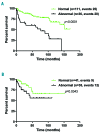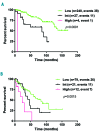Characteristics and clinical significance of cytogenetic abnormalities in polycythemia vera
- PMID: 28473622
- PMCID: PMC5685217
- DOI: 10.3324/haematol.2017.165795
Characteristics and clinical significance of cytogenetic abnormalities in polycythemia vera
Abstract
Up to 20% of patients with polycythemia vera have karyotypic abnormalities at the time of the initial diagnosis. However, the cytogenetic abnormalities in polycythemia vera have not been well characterized and their prognostic impact is largely unknown. In this study, we aimed to address these issues using a large cohort of polycythemia vera patients with cytogenetic information available. The study included 422 patients, 271 in polycythemic phase, 112 with post-polycythemic myelofibrosis, 11 in accelerated phase, and 28 in blast phase. Abnormal karyotypes were detected in 139 (33%) patients, ranging from 20% in those in the polycythemic phase to 90% among patients in accelerated/blast phase. Different phases harbored different abnormalities: isolated del(20q), +8 and +9 were the most common abnormalities in the polycythemic phase; del(20q) and +1q were the most common abnormalities in post-polycythemic myelofibrosis; and complex karyotypes were the most common karyotypes in accelerated and blast phases. Patients with an abnormal karyotype showed a higher frequency of disease progression, a shorter transformation-free survival and an inferior overall survival compared with patients with a normal karyotype in the same disease phase. Cytogenetics could be effectively stratified into three risk groups, low- (normal karyotype, sole +8, +9 and other single abnormality), intermediate- (sole del20q, +1q and other two abnormalities), and high-risk (complex karyotype) groups. We conclude that cytogenetic changes in polycythemia vera vary in different phases of disease, and carry different prognostic impacts.
Copyright© 2017 Ferrata Storti Foundation.
Figures




Similar articles
-
Morphologic and cytogenetic differences between post-polycythemic myelofibrosis and primary myelofibrosis in fibrotic stage.Mod Pathol. 2013 Dec;26(12):1577-85. doi: 10.1038/modpathol.2013.109. Epub 2013 Jun 21. Mod Pathol. 2013. PMID: 23787440
-
Karyotypic abnormalities in myelofibrosis following polycythemia vera.Cancer Genet Cytogenet. 2003 Jan 15;140(2):118-23. doi: 10.1016/s0165-4608(02)00678-7. Cancer Genet Cytogenet. 2003. PMID: 12645649
-
Bone marrow findings in blast phase of polycythemia vera.Ann Hematol. 2018 Mar;97(3):425-434. doi: 10.1007/s00277-017-3211-7. Epub 2017 Dec 28. Ann Hematol. 2018. PMID: 29285580
-
[Cytogenetics and molecular genetics in myelofibrosis with myeloid metaplasia and polycythemia vera].Pathol Biol (Paris). 2007 Feb;55(1):49-55. doi: 10.1016/j.patbio.2006.04.010. Epub 2006 Aug 9. Pathol Biol (Paris). 2007. PMID: 16901657 Review. French.
-
Karyotype and molecular cytogenetic studies in polycythemia vera.Curr Hematol Rep. 2005 May;4(3):224-9. Curr Hematol Rep. 2005. PMID: 15865876 Review.
Cited by
-
Disappearance of a chromosomal abnormality in a young patient with polycythemia vera treated with ropeginterferon alfa-2b.Ann Hematol. 2024 Sep;103(9):3825-3827. doi: 10.1007/s00277-024-05909-3. Epub 2024 Jul 25. Ann Hematol. 2024. PMID: 39052033 No abstract available.
-
Value of cytogenetic abnormalities in post-polycythemia vera and post-essential thrombocythemia myelofibrosis: a study of the MYSEC project.Haematologica. 2018 Sep;103(9):e392-e394. doi: 10.3324/haematol.2017.185751. Epub 2018 Apr 5. Haematologica. 2018. PMID: 29622658 Free PMC article. No abstract available.
-
Advanced forms of MPNs are accompanied by chromosomal abnormalities that lead to dysregulation of TP53.Blood Adv. 2018 Dec 26;2(24):3581-3589. doi: 10.1182/bloodadvances.2018024018. Blood Adv. 2018. PMID: 30563882 Free PMC article.
-
A molecular signature predicts hematologic evolution in polycythemia vera patients.Leukemia. 2025 Aug;39(8):1937-1947. doi: 10.1038/s41375-025-02660-0. Epub 2025 Jun 18. Leukemia. 2025. PMID: 40533498 Free PMC article.
-
Evolution of WHO diagnostic criteria in "Classical Myeloproliferative Neoplasms" compared with the International Consensus Classification.Blood Cancer J. 2025 Mar 4;15(1):31. doi: 10.1038/s41408-025-01235-7. Blood Cancer J. 2025. PMID: 40038244 Free PMC article. Review.
References
-
- Swerdlow SH, Campo C, Harris NL, et al. WHO Classification of Tumours of Haematopoietic and Lymphoid Tissues. Edited by International Agency for Research on Cancer : Lyon, 2008.
-
- Barbui T, Thiele J, Gisslinger H, Finazzi G, Vannucchi AM, Tefferi A. The 2016 revision of WHO classification of myeloproliferative neoplasms: clinical and molecular advances. Blood Rev. 2016;30(6):453–459. - PubMed
-
- Passamonti F, Rumi E, Caramella M, et al. A dynamic prognostic model to predict survival in post-polycythemia vera myelofibrosis. Blood. 2008;111(7):3383–3387. - PubMed
-
- Kennedy JA, Atenafu EG, Messner HA, et al. Treatment outcomes following leukemic transformation in Philadelphia-negative myeloproliferative neoplasms. Blood. 2013;121(14):2725–2733. - PubMed
MeSH terms
LinkOut - more resources
Full Text Sources
Other Literature Sources
Research Materials

